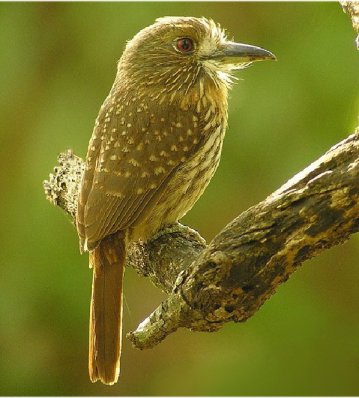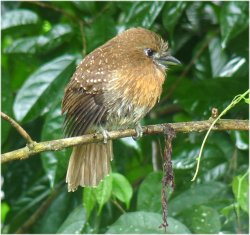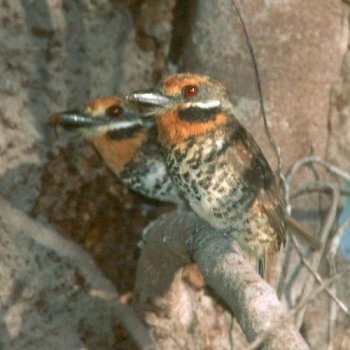Nine families of largely arboreal birds make
up the order Piciformes, the best-known of them being
the Picidae,
which
includes the woodpeckers and close relatives. The Piciformes
contain about 67 living genera with a little over 400
species, of which the Picidae
(woodpeckers and relatives) make up about half.
In general, the Piciformes are insectivorous, although the barbets
and toucans mostly eat fruit and the honeyguides are unique
among birds in being able to digest beeswax (although insects
make up the bulk of their diet). Nearly all Piciformes have
parrot-like zygodactyl feet—two toes forward and two back,
an arrangement that has obvious advantages for birds that
spend much of their time on tree trunks. An exception are a
few species of three-toed woodpeckers. The jacamars aside,
Piciformes do not have down feathers at any age, only
true feathers. They range in size from the Rufous Piculet at
8 cm in
length, and weighing 7 grams, to the Toco Toucan, at 63 centimetres
long, and weighing 680 grams All nest in cavities and
have altricial young. |
Order: PICIFORMES
Suborder Galbulae
Family
Galbulidae
- jacamars (18 species)
| Engelsk |
Norsk |
Latinsk |
| White-throated Jacamar |
Hvitmaskejakamar |
Brachygalba
albogularis |
| Pale-headed Jacamar |
Blekhodejakamar |
Brachygalba
goeringi |
| Brown
Jacamar |
Brunjakamar |
Brachygalba
lugubris |
| Dusky-backed Jacamar |
Mørkryggjakamar |
Brachygalba
salmoni |
| White-eared Jacamar |
Hvitø¸rejakamar |
Galbalcyrhynchus
leucotis |
| Chestnut Jacamar |
Kastanjejakamar |
Galbalcyrhynchus
purusianus |
| Yellow-billed Jacamar |
Gulnebbjakamar |
Galbula
albirostris |
| Purplish Jacamar |
Purpurjakamar |
Galbula
chalcothorax |
| Bluish-fronted Jacamar |
Blåpannejakamar |
Galbula
cyanescens |
| Blue-cheeked
Jacamar |
Blånakkejakamar |
Galbula
cyanicollis |
| Paradise
Jacamar |
Paradisjakamar |
Galbula
dea |
| Green-tailed Jacamar |
Grønnhalejakamar |
Galbula
galbula |
| Bronzy
Jacamar |
Bronsejakamar |
Galbula
leucogastra |
| Coppery-chested Jacamar |
Kobberjakamar |
Galbula
pastazae |
| Rufous-tailed Jacamar |
Rusthalejakamar |
Galbula
ruficauda photo |
| White-chinned Jacamar |
Hvithakejakamar |
Galbula
tombacea photo |
| Three-toed Jacamar |
Tretåjakamar |
Jacamaralcyon
tridactyla |
| Great
Jacamar |
Storjakamar |
Jacamerops
aureus |
|
List
of names: Source: Norsk Ornitologisk Forening
|
Family Bucconidae
- puffbirds, nunbirds and nunlets (some 30 species)
| Engelsk |
Norsk |
Latinsk |
| Collared Puffbird |
Rusthodedovenfugl |
Bucco
capensis |
| Chestnut-capped
Puffbird |
Brunkronedovenfugl |
Bucco
macrodactylus |
| Sooty-capped Puffbird |
Gråkinndovenfugl |
Bucco
noanamae |
| Spotted
Puffbird |
Tamatiadovenfugl |
Bucco
tamatia |
| Swallow-winged Puffbird |
Svalevinge |
Chelidoptera
tenebrosa |
| White-faced Nunbird |
Priorinnefugl
|
Hapaloptila
castanea |
| Two-banded Puffbird |
Tobeltedovenfugl |
Hypnelus
bicinctus |
| Russet-throated Puffbird |
Ruststrupedovenfugl |
Hypnelus
ruficollis |
| Black-streaked Puffbird |
Mørkdovenfugl |
Malacoptila
fulvogularis |
| White-chested Puffbird |
Oransjenebbdovenfugl |
Malacoptila
fusca |
| Moustached Puffbird
|
Mustasjedovenfugl |
Malacoptila
mystacalis photo |
| White-whiskered
Puffbird |
Hvitskjeggdovenfugl |
Malacoptila
panamensis |
| Rufous-necked Puffbird |
Rustkragedovenfugl |
Malacoptila
rufa |
| Semicollared Puffbird |
Rustnakkedovenfugl |
Malacoptila
semicincta |
| Crescent-chested Puffbird
|
Halvmånedovenfugl |
Malacoptila
striata photo |
| Lanceolated Monklet |
Munkedovenfugl |
Micromonacha
lanceolata |
| Black Nunbird |
Svartklarisse |
Monasa
atra photo |
| Black-fronted Nunbird |
Sotklarisse |
Monasa
nigrifrons photo |
| White-fronted Nunbird |
Hvitpanneklarisse |
Monasa
morphoeus photo |
| Yellow-billed Nunbird |
Gulnebbklarisse |
Monasa
flavirostris |
| Rusty-breasted Nunlet |
Rødbrystnovise |
Nonnula
rubecula |
| Fulvous-chinned Nunlet |
Brunkinnovise |
Nonnula
sclateri |
| Brown Nunlet |
Brunnovise |
Nonnula
brunnea |
| Gray-cheeked Nunlet |
Gråkinnovise |
Nonnula
frontalis |
| Rufous-capped Nunlet |
Rustkronenovise |
Nonnula
ruficapilla |
| Chestnut-headed Nunlet |
Nøttehodenovise |
Nonnula
amaurocephala |
| Guinean
Puffbird |
|
Notharchus
macrorhynchos |
| White-necked
Puffbird |
Hvitpannedovenfugl |
Notharchus
hyperrynchus |
| Brown-banded Puffbird |
Brunbeltedovenfugl |
Notharchus
ordii |
| Black-breasted Puffbird |
Svartbrystdovenfugl |
Notharchus
pectoralis photo |
| Buff-bellied Puffbird |
Rustbukdovenfugl |
Notharchus
swainsoni |
| Pied Puffbird |
Perledovenfugl |
Notharchus
tectus photo |
| White-eared Puffbird |
Hvitøredovenfugl |
Nystalus
chacuru |
| Spot-backed Puffbird |
Flekkdovenfugl |
Nystalus
maculatus |
| Barred Puffbird |
Skjelldovenfugl |
Nystalus
radiatus photo |
| Striolated Puffbird |
Stripedovenfugl |
Nystalus
striolatus |
Suborder Pici
Family Lybiidae
- African barbets (about 40 species, recently split from Capitonidae)
Family Megalaimidae
- Asian barbets (about 25 species, recently split from Capitonidae)
Family Ramphastidae
- toucans (about 40 species)
Family Semnornithidae
- toucan-barbets (2 species, recently split from Capitonidae)
Family Capitonidae
- American barbets (about 15 species)
Family
Picidae - woodpeckers, piculets and
wrynecks (over 200 species)
Family Indicatoridae
- honeyguides (17 species) |
Galbulidae
The jacamars are a family, Galbulidae, of near passerine
birds from tropical South and Central America, extending up
to
Mexico. The order contains five genera and 18 species. The family
is closely related to the puffbirds, another Neotropical
family, and the two families are often separated into their
own order away from the Piciformes, instead being placed
in the
Galbuliformes. They are principally birds of low altitude
woodlands and forests, and particularly of forest edge and canopy.
The jacamars are small to medium sized perching birds ranging
between 14–34 cm in length and weighing between 17-75 g.
They are glossy elegant birds with long bills and tails. In
appearance and behaviour they show resemblances to the Old
World bee-eaters, as most ariel insectivores tend to have short
wide bills as opposed to long thin ones. The legs are short
and weak, and the feet are zygodactyl. Their plumage is often
bright and highly iridescent, although it is quite dull in a
few
species. There are minor differences in plumage based on sex,
males often having a white patch on the breast.
Jacamars are insectivores, taking a variety of insect prey (many
specialize on butterflies and moths) by hawking in the air.
Birds sit in favoured perches and sally towards the prey when
it is close enough. Only the Great Jacamar varies from
the rest of the family, taking prey by gleaning and occasionally
taking small lizards and spiders.
The breeding systems of jacamars have not been studied in depth.
They are thought to generally be monogamous, although
a few species are thought to sometimes engage in cooperative
breeding with several adults sharing duties. The family nests
in holes either in the soil or in arboreal termite
mounds. Ground nesting species usually nest in the banks of
rivers (or more
recently, roads), although if these are not available they will
nest in the soil held by the roots of fallen trees. Bank-nesting
jacamars can sometimes be loosely colonial. Clutch sizes are
between 1-4 eggs, with 2-4 being more common.
Both parents participate in incubation. Little is known about
the incubation times of most species, although it lasts for
between 19–26 days in the Rufous-tailed Jacamar. Chicks
are born with down feathers, unique among the piciformes.
|

Rufous-tailed
Jacamar
Photo: Dario Sanches |

Perched male
Rufous-tailed Jacamar
http://en.wikipedia.org/wiki/File:Galbula_ruficauda_-_front.jpg
|

Galbula tombacea
mentalis, Brazil
Photo: Cláudio Dias Timm |
 Brown
Jacamar, Brachygalba lugubris. Brazil
Brown
Jacamar, Brachygalba lugubris. Brazil
© www.arthurgrosset.com
|
The Brown Jacamar, Brachygalba lugubris, is found in
Bolivia, Brazil, Colombia, Ecuador, French Guiana, Guyana, Peru,
Suriname, and Venezuela. Its natural habitats are subtropical
or tropical moist lowland forests and heavily degraded former
forest. |

Great Jacamar, Jacamerops aureus. Panama
Photo: Dominic Sherony |
The Great Jacamar, Jacamerops aureus, is found in Bolivia,
Brazil, Colombia, Costa Rica, Ecuador, French Guiana, Guyana,
Panama, Peru, Suriname, and Venezuela. Its natural habitat is
subtropical or tropical moist lowland forests. |
 Female
Bronzy Jacamar, Galbula leucogastra
Female
Bronzy Jacamar, Galbula leucogastra
Female has a buff throat and belly, male has white..
© www.arthurgrosset.com
|
The Bronzy Jacamar, Galbula leucogastra, occurs
in the countries of Bolivia, Brazil, Colombia, French Guiana,
Guyana, Suriname, and Venezuela. Its natural habitats are subtropical
or tropical moist lowland forests and subtropical or tropical
dry shrubland. |
 Blue-necked
Jacamar, Galbula cyanicollis
Blue-necked
Jacamar, Galbula cyanicollis
© www.arthurgrosset.com
|
The Blue-necked Jacamar or Blue-cheeked Jacamar,
Galbula cyanicollis, is found in Bolivia, Brazil, and Peru.
Its natural habitat is subtropical or tropical moist lowland
forests. |
 Paradise
Jacamar, Galbula dea. Brazil
Paradise
Jacamar, Galbula dea. Brazil
© www.arthurgrosset.com |
The Paradise Jacamar has a distinctive silhouette with it
needle-like bill and its long, stiletto shaped tail.
At a distance, it looks black with a white throat but its crown
is a browny colour and its wings are a bronzy-green.
The Paradise Jacamar is normally found in the forest canopy
(often perched on dead branches)
in comparison with the greener members of the genus such as
Green-tailed Jacamar,
G. galbula and Rufous-tailed Jacamar, G. ruficauda, which
are to be found low down in the forest.
There are 4 sub-species which differ slightly in length of
wing, bill and tail and in the colour of the crown.
Text: www.arthurgrosset.com
|
Bucconidae
The puffbirds and their relatives in the near passerine family
Bucconidae are tropical birds breeding from South America up
to Mexico.
They are related to the jacamars, but lack the iridescent colours
of that family. They are mainly brown, rufous or grey, with
large
heads and flattened bills with a hooked tip. The loose abundant
plumage and short tails makes them look stout and puffy, giving
rise to the English name of the family. They feed on insects
and small vertebrates caught by a watch and wait technique.
The species range in size from the Rufous-capped Nunlet, at
13 cm and 14 grams , to the White-necked Puffbird,
at up to 29 cm and 106 grams.
Like most of their relatives, this group are hole nesters, laying
2–3 glossy white eggs in a hole in the ground or a termite
mound..
 White-necked
Puffbird, Notharchus hyperrhynchus. 2009.
White-necked
Puffbird, Notharchus hyperrhynchus. 2009.
http://en.wikipedia.org/wiki/White-necked_Puffbird
|
The Guianan Puffbird, Notharchus macrorhynchos, is
a species of puffbird in the Bucconidae family. It is found
in forest and
woodland in north-eastern South America, (and named after
the Guianas), in far eastern Venezuela, north-eastern Brazil,
Guyana, Suriname and French Guiana. It formerly included Notharchus
hyperrhynchus as a subspecies, but under the common
name White-necked Puffbird (the name now used for Notharchus
hyperrhynchus).
|

Black-breasted
Puffbird,
Notharchus pectoralis
http://en.wikipedia.org/wiki/Black-breasted_Puffbird |

Pied Puffbird,
Notharchus tectus. Panama
Photo: Dominic Sherony
|

Chestnut-capped
Puffbird,
Bucco macrodactylus
http://en.wikipedia.org/wiki/File:Chestnut-capped_Puffbird.jpg
|
Chestnut-capped
Puffbird, Bucco macrodactylus,
The Chestnut-capped Puffbird, Bucco macrodactylus,
(right picture above), is found in northwestern South America
in the
western Amazon Basin of Brazil, and Amazonian Venezuela, Colombia,
Ecuador, Peru, and northern Bolivia; also the
eastern Orinoco River Basin of Venezuela.
Its natural habitats are subtropical or tropical moist lowland
forests and subtropical or tropical swamps.
It is a small, roundish dark brown bird with a short narrow
tail, and a dull whitish breast. It is a bright multicolored
bird, named
for its cap, which is a deep chestnut; a medium orange, narrow
collar on the upper back borders the chestnut cap and ends at
the side of the neck in a spot. A second collar similar to the
Collared Puffbird's is on the upper breast, wider on the sides,
narrow under the throat, and deep black. The black collar is
parallel to a second deep black stripe, an eye-stripe across
the
lower eye from the side to the bill. The deep chestnut cap and
two black stripes enclose two parallel bright white stripes.
The bill is stout, short and medium black, with a decurved tip.
The bird has black eyes, black legs, and also short light-buff
whiskered-feathers surrounding the base of its bill, (moustachial).
These bright head colors are all contrasted against a duller
colored body and breast.
|
Pied
Puffbird, Notharchus tectus
|
The Pied Puffbird, Notharchus tectus, photo
above, is a species of puffbird in the Bucconidae
family.
It is found in Bolivia, Brazil, Colombia, Costa Rica, Ecuador,
French Guiana, Guyana, Panama, Peru, Suriname, and Venezuela.
Its natural habitats are subtropical or tropical moist lowland
forests and heavily degraded former forest.
This is one of the smaller puffbirds at 15 cm and is a bit like
a miniature White-necked Puffbird,
Notharchus. macrorhynchus,
except that it has white spots on its crown and a white supercilium.
This nest can be in a termites' nest about 3 metres up a tree.
The puffbird excavates a chamber in the termites nest and the
termites immediately restore the walls opened by the puffbird
but leave the puffbird's chamber undisturbed. I assume that
there
is some sort of symbiotic relationship between the termites
and the puffbird but I don't know what it might be.
Will try to find more about symbiosis
later. Se another example of symiosis
here. |
White-whiskered Puffbird, Malacoptila panamensis

White whiskered Puffbird
Malacoptila panamensis
Photo:
Len Blumin |
The White-whiskered Puffbird, Malacoptila panamensis,
is a bird which is a resident breeding species from southeastern
Mexico
to central Ecuador. It is sometimes known as White-whiskered
Softwing.
This puffbird is found in forests, shady plantations, especially
of Theobroma cacao, and old second growth in lowlands and
foothills up to 1200m. It nests in a 15-55 cm long, 6 cm diameter
burrow in, usually, gently sloping ground. The wider nesting
chamber is lined with dried leaves. The female lays 2, rarely
3, glossy white eggs; both sexes incubate the eggs and feed
the young.
The White-whiskered Puffbird is a stout, large-headed, 18 cm
long bird which weighs 42 g on average. It has bristles around
the
base of the large bill, and white “whiskers”, actually
tufts of feathers. The adult male has pale brown upperparts
and tail, with fine
cinnamon spotting on the wings and crown. The underparts are
cinnamon-buff, streaked darker, and becoming paler moving down
the body to the almost white vent area. The female has a greyer
brown back and darker streaks on the paler underparts,
giving her a more contrasted appearance than the male.
Young birds are like the female but have barring on the upperparts
and narrower streaks on the underparts.
Like other puffbirds, this species hunts by a watch-and-wait
technique, sitting motionless before darting to catch large
insects,
spiders, small frogs or lizards. These are taken back to the
perch and beaten against it prior to consumption. Despite its
size,
this species is easily overlooked as it sits motionless in the
foliage. |
 Moustached
Puffbird,
Moustached
Puffbird,
Malacoptila mystacalis, Colombia
Photo: Julian Londono |

Barred Puffbird,
Nystalus radiatus, Panama
http://en.wikipedia.org/wiki/Barred_Puffbird |

Crescent-chested
Puffbird,
Malacoptila striata, Brazil
Photo: Dario Sanches |
Spotted
Puffbird, Bucco tamatia
|
|
|
|
Spotted
Puffbird, Bucco tamatia
Roraima, Brazil, July 2001
© www.arthurgrosset.com
|
The
Spotted Puffbird, Bucco tamatia, with its black bill,
red iris, orange forehead, throat and upper chest, white malar
stripe
and black patch on the side of its neck is unlikely to be confused.
It is found in Bolivia, Brazil, Colombia, Ecuador, French
Guiana, Guyana, Peru, Suriname, and Venezuela. Its preferred
habitat
seems to be gallery forest, the edges of várzea forest
and Mauritia palm groves which is where these birds were found.
Like most puffbirds, they can be hard to spot because they
spend a lot of time motionless. However, once spotted they
can be very confiding and allow you to get quite close.
These birds were feeding on a termite
nest and may have been excavating a nest of their own. If
so, the termites would restore
the walls opened up by the puffbirds but leave the nest chamber
made by them.
Source: © www.arthurgrosset.com
|

White-fronted Nunbird, Monasa morphoeus
Brazil
© www.arthurgrosset.com
|

Black Nunbird, Monasa atra.
Brazil
© www.arthurgrosset.com
|

Black-fronted Nunbird, Monasa nigrifrons
Brazil
© www.arthurgrosset.com
|
Text on this page if nothing else is stated,
comes from Wikipedia.
|




























